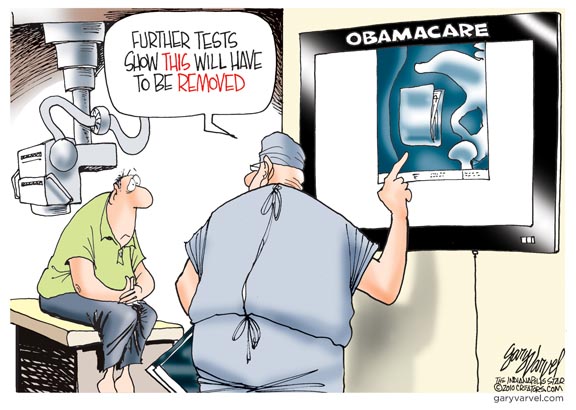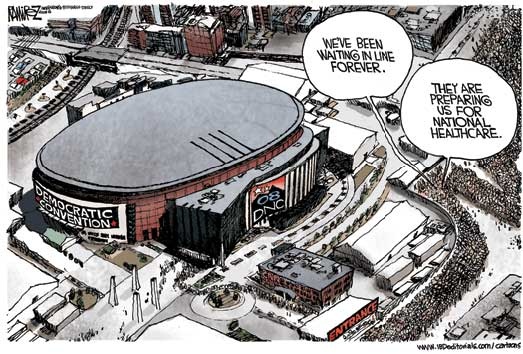The cost of healthcare is out of control.

Update
I recently read a very detailed book on the various sources of cost in the American healthcare system, “An American Sickness“, which describes all the components and players involved in delivering medical care. It’s fairly clear that one critical step in the right direction of getting control over the cost of healthcare is to provide much greater transparency into the cost/price of every medical procedure. That is, take the first step in getting the consumer more actively involved in evaluating the cost/benefit of each healthcare intervention.
July 20, 2018
The discussions about healthcare and socialized medicine appear to have taken a back seat to current economic issues, but the challenge of escalating costs continues. Recently, the Goodman Institute shared the ‘revolutionary’ notion of applying the free market in healthcare:
For as long as I have been in the field, health economics has been dominated by the idea that the free market can’t work in health care. Being a contrarian, I’m prepared to ask: What if the free market could work? What would it look like?
…
The average knee replacement on MediBid costs around $15,000. The normal charge by U.S. hospitals is around $60,000 and the average insurance payment is about $36,500. A similar range exists for hip replacements, with an average Medibid price of about $19,000.
October 27, 2016
What’s worse than Obamacare?
Simple: Hillarycare.
If she becomes President, you can count on more Government control of healthcare and a downward spiral in the quality of medical services.
This week, the White House finally admitted what had become obvious for months: premiums within the Affordable Care Act (ACA) exchanges will skyrocket in 2017. Unfortunately, neither the administration nor its intended successor Hillary Clinton demonstrated a grip on the failures that have driven the markets to collapse, or the need for a clear change in direction. Instead, both argued for Band-Aids that will make matters even worse.
Source: The Fiscal Times
We are at a juncture of time where your voting decisions are deciding the future of your family.
May 1, 2016
The Slow Economic Death from Obamacare… A good summary over at American Thinker:
Obamacare… the road to hell is paved with good intentions. The first major bump in the road is the concept of essential benefits. According to the Obamacare website, “Ten essential health benefits must be offered at no dollar limits on every plan under the Affordable Care Act.” Much like having to buy every option for your new car even if you only want the basics.
The next bump concerns pre-existing conditions. “No more pre-existing conditions means you can’t be denied coverage, charged more, or denied treatment based on health status.”
The third bump is called guaranteed issue. “ObamaCare makes health insurance guaranteed issue meaning you can’t be denied health status, age, gender, or other factors.”These three features are hallmarks of Obamacare, allowing anyone and everyone to receive healthcare insurance, regardless of their health, age, or concurrent illnesses, and have coverage well beyond what that particular individual needs. Compassionate and fair? Sure. Economically realistic. No way.
October 21, 2013
As mentioned numerous times on this blog, it all about addressing the issue of OPM – Other Peoples Money. That it, people must have a stake in the cost and delivery of their healthcare:
Give consumers an incentive to care about the cost of medical care and the cost of medical care will decline. That’s economics 101 (a course Barack Obama obviously didn’t take), straight out of Adam Smith…
The fact is, 315 million consumers of health care saying, “How much is this going to cost” will rein in healthcare expenditures far more effectively than 315,000 government bureaucrats meddling in the marketplace
via How to Cut Medical Costs 101.
September 19, 2013
This is a very important article in Harvard Business Review, which talks about better ways to encourage price shopping for healthcare:
[W]e need to understand why Americans aren’t bargain hunters for health care, especially given the constant drumbeat about the high cost of health care in the United States… One potential reason these initiatives have little bite is that most insured consumers pay only a fraction of the true cost of health care and thus have little incentive to shop for lower-cost care.
…
Moving forward, we need to harmonize patient-oriented and provider-oriented strategies for encouraging price shopping. Patients need easily accessible information about price that is tailored to their individual needs. This information should include not only the out-of-pocket price of the service (e.g., a doctor visit) but also more holistic information on downstream costs for the entire episode of care and data on the quality of care.
July 15, 2012
The citizens of the US don’t yet appreciate how screwed-up the approach to healthcare is going to be under Obamacare… I’ve mentioned to my colleagues numerous times that OPM (“Other People’s Money”) is the underlying problem with the notion of our healthcare system — that is, when you’re not the one picking up the tab, you’re less concerned with the cost. As a result, the cost goes up unabated and the quality of the service goes down.
You can watch this simple video below that does a nice job of explaining the likely results from our move towards socialized medicine.
March 7, 2012
Healthcare and OPM
I always view the issue of “Other People’s Money” as the primary source of economic problems. OPM is the core problem with healthcare costs… Of course, OPM is the opiate for the Obama supporters. Thus, the focus on the Obama “budget”.

May 4, 2010
Well, the medical insurance premiums for our small business just increased 21% this year… I can see that Obamacare is working already.

November 26, 2010
Here’s a way to improve service by combining TSA airport security with physical exams…

Septembr 27, 2009
A great article from Greg Mankiw in the New York Times… He discusses the economic implications of healthcare. A few key extracts:
“One thing I did not consider was the price. Like most consumers of health care, I was insulated from economic concerns. I knew that the insurance company — and, indirectly, all its policyholders — would pick up most of the tab. This arrangement, encouraged by the tax system, ensures that I get the benefit of the pills while paying little of the extra costs they generate…
Despite all the talk about waste and abuse in our health system (which no doubt exists to some degree), the main driver of increasing health care costs is advances in medical technology. The medical profession is always figuring out new ways to prolong and enhance life, and that is a good thing, but those new technologies do not come cheap. For each new treatment, we have to figure out if it is worth the price, and who is going to get it.
The push for universal coverage is based on the appealing premise that everyone should have access to the best health care possible whenever they need it. That soft-hearted aspiration, however, runs into the hardheaded reality that state-of-the-art health care is increasingly expensive. At some point, someone in the system has to say there are some things we will not pay for. The big question is, who? The government? Insurance companies? Or consumers themselves? And should the answer necessarily be the same for everyone?”
September 4, 2008
A Democrat’s approach to prepare for single payer healthcare…

Amazingly simple way of stating the facts and problems with Obamacare!